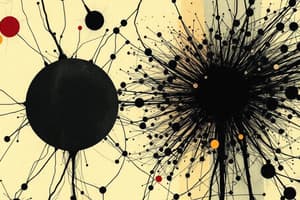Podcast
Questions and Answers
What type of microscope can be used to view living specimens in natural colors?
What type of microscope can be used to view living specimens in natural colors?
- Cryogenic electron microscope
- Scanning electron microscope
- Transmission electron microscope
- Light microscope (correct)
What is the primary function of synthetic dyes in light microscopy?
What is the primary function of synthetic dyes in light microscopy?
- To bind particular cellular compounds (correct)
- To generate monochromatic images
- To improve image resolution
- To enhance 3D mapping of structures
How do electron microscopes differ from light microscopes in terms of specimen viewing?
How do electron microscopes differ from light microscopes in terms of specimen viewing?
- They use glass lenses for magnification
- They can view specimens in higher natural colors
- They only produce monochromatic images (correct)
- They allow for live specimen observation
What does a transmission electron microscope (TEM) do with electrons?
What does a transmission electron microscope (TEM) do with electrons?
What is one technique used in cryogenic electron microscopy?
What is one technique used in cryogenic electron microscopy?
What is the purpose of immunofluorescence staining?
What is the purpose of immunofluorescence staining?
What feature of electron microscopes allows for a higher magnification compared to light microscopes?
What feature of electron microscopes allows for a higher magnification compared to light microscopes?
What do scanning electron microscopes (SEMs) primarily achieve?
What do scanning electron microscopes (SEMs) primarily achieve?
Flashcards are hidden until you start studying
Study Notes
Microscopes Overview
- Scientific instruments that visualize objects too small for the naked eye.
- Two primary types: optical (light) microscopes and electron microscopes.
Light Microscopy
- Capable of viewing living specimens in their natural colors.
- Utilizes glass lenses to bend light, with magnification determined by the lens type.
- Clarity of cellular structures enhances with fluorescent labeling techniques.
- Synthetic dyes bind to specific cellular compounds, resolving structures; for example:
- DAPI: fluorescent dye that stains DNA.
- Immunofluorescence staining employs antibodies conjugated to fluorescent probes to selectively target specific cellular components.
Electron Microscopy
- Provides significantly higher magnification and resolution than light microscopy but cannot view living specimens in natural colors.
- Uses electromagnets to focus electrons and generate monochromatic images, which can be colorized afterward.
- Two major types:
- Transmission Electron Microscopes (TEMs): Electrons pass through specimens, creating cross-sectional images.
- Scanning Electron Microscopes (SEMs): Electrons scatter over specimen surfaces, allowing for depth differentiation and 3D mapping.
Cryogenic Electron Microscopy
- Involves freezing samples before imaging, yielding results comparable to X-ray crystallography.
- Enables determination of molecular structures at near-atomic resolution without the need for crystallization.
- Frozen specimens can be cracked along planes using freeze fracturing, allowing internal cellular structures to be examined.
- Demonstrated the presence of integral membrane proteins within the plasma membrane through freeze fracturing techniques.
Studying That Suits You
Use AI to generate personalized quizzes and flashcards to suit your learning preferences.




